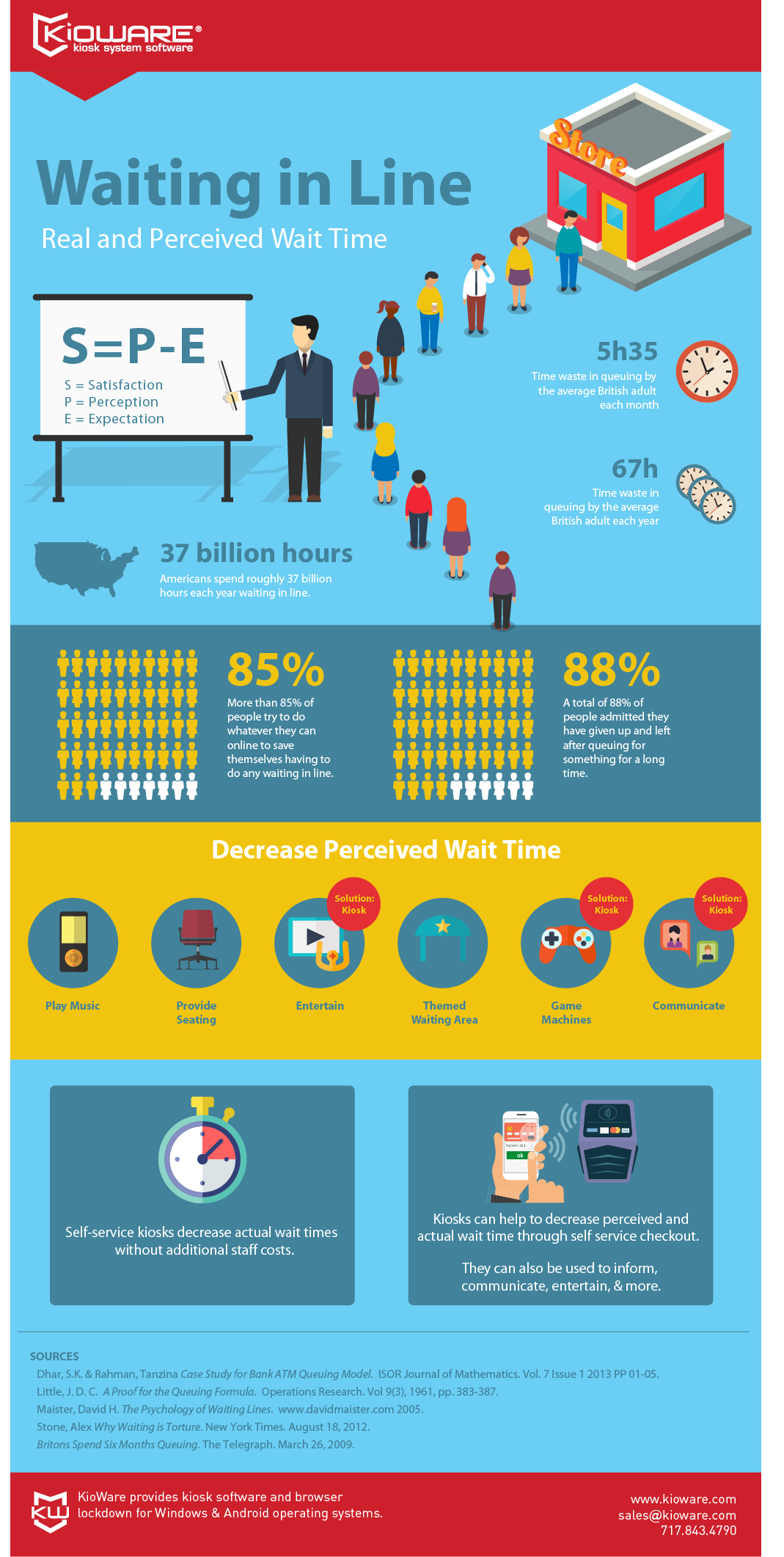
Getting Buy-In
Minimizing Wait Times
Queueing Theory - How do Customers Queue?
Minimizing Wait Times
 How Do Customers Queue?
How Do Customers Queue?
Queueing Theory is the study of queue or waiting lines. The theory of queueing was proposed by AK Erlang in 1903, so queueing theory predates the technology often used to improve the queueing process.
Factors in a queueing system include:
- Input (when a customer arrives or joins the line)
- Service (how many devices or individuals provide the service as well as what kind of service is provided)
- Queue discipline (how the queue functions and is processed –in what order are people served in relation to when they arrive and what service is being provided)
- Customer behavior (do they leave because of the queue, do they alter their queueing behavior based on wait time), etc.
Queueing theory considers how organizations can impact line length, wait time, and customer satisfaction.
What is the role of kiosks in queueing theory and which factors are most impacted by the presence of kiosks? One case study, by SK Dhar & Tanzinia Rahman, evaluated Bank ATMs and how queues are impacted by ATM options. In this particular study, the presence of ATMs decreased the number of people leaving the bank without service. Measurements were taken to determine how many ATMs were required to serve people in the bank and decrease lines enough to reduce or remove the number of customers going away.
Kiosks Protect From Loss of Customers Due to Lines
One role of kiosks then, the most measurable one, is the ability to reduce/remove the number of customers lost due to lines.
The very real cost of customers leaving or opting out of the queue is easily remedied with self-service kiosks that allow customers to perform certain tasks without assistance. Much like the transactional services available at an ATM, not all transactions can be performed at all kiosks. However, removing the number of people in the queue frees up service providers to perform more complicated tasks while at the same time allowing people to opt for a shorter wait time if they are not in need of a teller.
While queueing theory addresses the process and science of serving customers, it does not address the psychology of customers in the queue. Studies show that customers are more satisfied with the queue and/or service if the line is equitable, as in, there is a proper system being followed by which people are serviced in the order of their arrival to the queue. If they feel unfairly slighted by the queueing process, customer satisfaction and willingness to wait in the queue declines.
Customers must believe that the value of the product or service they are waiting for exceeds the value of the time they are losing or any opportunities they might be missing. Richard Larson calls this “social justice” and writes that it is expected, in the world of “fair and just” lines, that customers will be served on a “first in first out“ basis. If this social justice is not present, customers will opt out of the queue and move on to another service provider or service option.
Additionally, customers may feel differently about queues depending on the environmental factors that can impact not only actual wait time, but perceived wait time. Customer satisfaction, according to David Maister, is directly related to the perception and expectation one has for a particular level of service. The higher the expectation, the bigger the opportunity for disappointment.
In a famous work by Sasser, Olsen, & Wyckoff, guest satisfaction was increased with regard to elevator wait time, by the simple addition of mirrors to the waiting area. The perceived wait time went down, though the actual wait time stayed constant, and thus customer satisfaction increased.
Maister’s Premises:
Occupied time feels shorter than unoccupied time.
People want to get started
Anxiety makes waits seem longer
Uncertain waits are longer than known, finite waits
Unexplained waits are longer than explained waits
Unfair waits are longer than equitable waits
The more valuable the service, the longer the customer will wait
Solo waits feel longer than group waits
With this list, it is easy to see that there are opportunities, using kiosks specifically, and other techniques more generally, to improve customer satisfaction and decrease perceived wait time.
Occupied Time Feels Shorter Than Unoccupied Time
Use kiosks to occupy your customer’s time. Fill out a survey, search inventory, play a game, apply for a credit card, read the organization’s mission, learn about a particular product or service, or any number of other tasks that can be performed via a self-service kiosk. This is both the simplest to do and the most valuable, as it will occupy customer time and improve their satisfaction by decreasing perceived wait time.
People Want to Get Started
If you set up a kiosk that allows people to start their transaction, or initiate the service they will be provided, they will likely have an improved experience with a shorter perceived wait time, even if actual wait time is not impacted.
Anxiety Makes Wait Seem Longer
Reduce anxiety by allowing customers to educate themselves on their health options, or learn more about a particular issue. If anxiety is not health related, but is instead financial, alleviate anxiety by providing customers with opportunities to check their financial health online while they wait for the bank teller. Figure out where the anxiety might be, and work to alleviate it using a self-service kiosk.
The More Valuable the Service, the Longer the Customer Will Wait
To this degree, allow those that have less valuable transactions (fewer items for instance) to self-checkout using a kiosk. They will feel valued because they didn’t have to wait in line, and you will get that smaller sale without alienating another customer.
Actual and perceived wait time can be positively impacted with the implementation of kiosks, effectively improving customer satisfaction, decreasing wait time, and increasing the number of transactions.
___________________________________________________________
Sources:
Dhar, S.K. & Rahman, Tanzina. Case Study for Bank ATM Queuing Model. ISOR Journal of Mathematics Vol. 7 Issue 1 2013 PP 01-05.
Little, J. D. C. A Proof for the Queuing Formula. Operations Research, vol 9(3), 1961, pp. 383-387.
Maister, David H. The Psychology of Waiting Lines. www.davidmaister.com 2005.
Stone, Alex. Why Waiting is Torture. New York Times August 18, 2012.
Britons spend six months queuing. The Telegraph. March 26, 2009.
